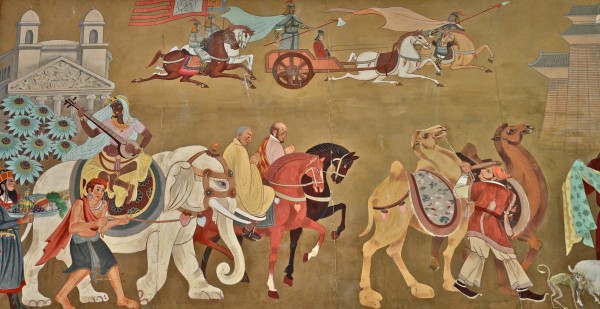My idea is Magyars came from Nepal where to this day there is a Magar population and settled as one of the last outposts of the silk road, during and after Roman times and they might be more culturally related with Magyars than with the surrounding population though in more than one thousand years they exchanged much of the genetic materials with Romanians which were all around.
They have this very interesting ancient balad about a yellow snake and a young man that had his hand swallowed by the snake (song posted below has been re-written in Magyar).
Could it be about a yellow snake or even yellow river. https://translate.google.com/#zh-CN/hu/%E8%9B%87
https://youtu.be/T8SaaNlkNW4?t=1m23s
"The Tang captured the vital route through the Gilgit Valley from Tibet in 722, lost it to the Tibetans in 737, and regained it under the command of the Goguryeo-Korean General Gao Xianzhi.
While the Turks were settled in the Ordos region (former territory of the Xiongnu), the Tang government took on the military policy of dominating the central steppe."
https://en.wikipedia.org/wiki/Silk_Road#Tang_dynasty_reopens_the_route
Unlike any other European language, modern day Magyar language has mixed elements of Turkic and Chinese language and is also related to Sumerian (like Turkish is) and also to Japanese. Sumerian. https://drive.google.com/open?id=0B-ShIhkErMIPU2N3WGl5TGh4Y1U

This map from the times of Marco Polo (1254-1324) is the last one with an outpost close to present day Romania.

Since they had no agricultural skills all they could do was coral the local population in the space of Carpathian Mountains, roughly present day Transylvania (now part of Romania) by placing the bulk of their numbers at the west or the border with Holy Roman Empire or Panonia or Tisza valley (left on this map) where they where no mountains and smaller numbers in the mountains (slightly different population of Shekelies) and catching the Romanians in the middle which were turned into slave laborarers. Today the situation has changed to the opposite, with 1-2 million Shekelies caught in the middle or Romania and surrounded by Romanians. Rest is... official history.

10 comments:
"The Romans thought [silk] a vegetable product combed from trees and valued it at its weight in gold."
"Up through the time of the emperor Marcus Aurelius (161-180 CE), silk was the most valued commodity in Rome"
http://www.ancient.eu/Silk_Road/
"Over 2,500 years the 4,000 mile route evolved into a vast sprawling network of trading trails. Only in 1877, did German geographer, Baron Ferdinand ... give the journey the tidy title of The Silk Road. Silk, a rare and prized fabric in Julius Ceasar’s day, was one commodity, along with jade, gold, amber, ivory and tea. These treasures were packed onto bactrian camels which traveled in groups of 100 or more. These were called caravans and they traveled about twenty-five miles a day."
"The other was at Samarkand, a legendary silk road city"
http://www.angelanealworld.com/ancient-silk-road/the-ancient-silk-road/
https://www.google.com/search?q=Cities+along+the+Silk+Road
Katmandu, Patan & Bhaktapur, Nepal, are among those.
https://en.wikipedia.org/wiki/Cities_along_the_Silk_Road
http://georgesblogforfriends.blogspot.com/2017/03/beautiful-moment.html
"The caravan traffic proceeded at a slow pace. A good day's journey covered 8 farsahs (50 km), a not so good one 4 farsahs (25 km). The composition of the caravan trains varied. There are numerous records of some huge trains containing up to 10,000 beasts of burden. All along the route, caravan-sarais (meeting places) appeared at regular intervals. Torrential streams were tamed with bridges. There was little caravan traffic from China to the Mediterranean. Because the international route opened up access to new places, settled crop production began, alongside nomadic livestock breeding."
https://orexca.com/silkroad.php
This map shows wrongfully Greece where Romania is.
https://orexca.com/img/silk_road.jpg
10,000 animals and probably as many people is a huge number by the standards of those times. If they would have settled they could have formed a small country.
Very interesting.
"Different caravans carried goods during different sections, with traders coming from the west exchanging thing like gold, wool, horses or jade for silk coming from the east. The caravans stopped at fortresses and oases along the way, passing their loads from trader to trader, with each transaction increasing the price as the traders took their cut."
"Caravanserai had rooms for caravan members, fodder and resting places for animals and warehouses for storing goods. They were often in small fortresses with guards to protect the caravans from bandits."
http://factsanddetails.com/world/cat52/sub331/item1182.html
Serica era numele latin al țării din care venea mătasea pe vremea romanilor. Termenul există și în limba română unde probabil vine ca neologism din franceză sau latină sub forma cuvântului sericicultură. Ce e interesant e că Seres era numele dat de către romani locuitorilor acestei țări. Să fie oare o legătură cu numele Seres, cu variante ca Selesz, Soros etc., care sunt atât de frecvente în Ungaria de azi.
"The people of Serica were the Seres, whose name was also used for their region."
Servus!
https://en.wikipedia.org/wiki/Serica
https://en.wikipedia.org/wiki/Sherpa_people
https://youtu.be/G54hH1LiVEQ?t=1m17s
Post a Comment
Friendly comments welcome
Note: Only a member of this blog may post a comment.